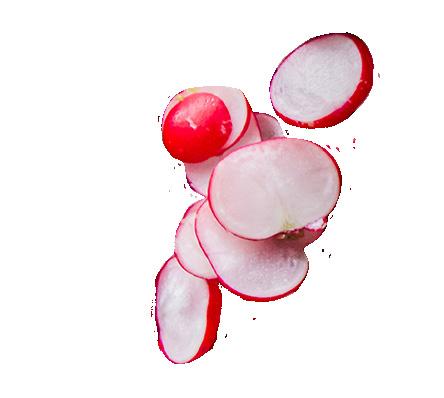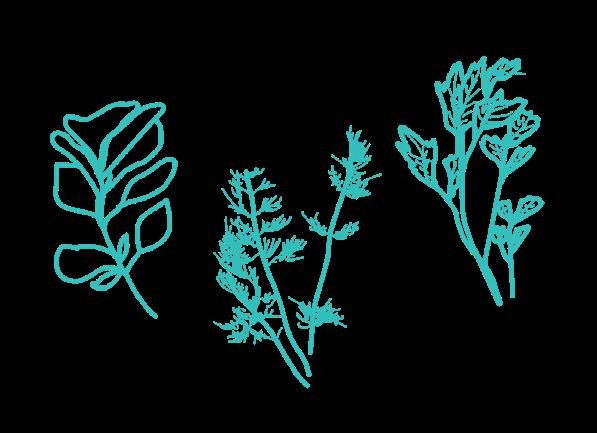










Gardening, and particularly, grow-yourown, has had a huge surge in popularity over the past couple of years as we turn to a more sustainable way of living.
As well as this, for those of us looking to eat more fruit and veg and adopt a healthier lifestyle, grow your own can seriously cut down the cost of our food bills.

Imagine not buying any veg for months, because you planted a few seeds?! It’ll save you heaps of money! And, if saving money and being more sustainable isn’t enough, when it comes to diet and exercise, gardening is a fantastic way to burn calories with all the digging, mowing and sowing!
Furthermore, it is a calming and wonderful way to spend a few hours of the weekend, especially as the spring weather starts to warm us up.
So just how can you go about growing your own?
Well you’re in luck because The Slimming Clinic have put together this super handy guide to help you on your way to becoming a green-fingered whizz!
The brilliant news is – it’s really simple to start too.
So, dust off your shorts, find that spade that’s long been hidden at the back of the shed and is gathering cobwebs and get out in the fresh spring air into your garden!
Whether you’re going to give the fence a paint, trim the hedge you’ve been promising to, plant some new things or just mow the lawn, now is a wonderful time to get into the garden and help support yourself get back into shape.


Don’t own a garden? We’ve not forgotten you – we’ve also included our favourite plants that can be sown, grown and harvested all from inside your home! Head to the back of this guide for more information.



We know that the thought of growing your own can seem a little overwhelming to some, but it really couldn’t be simpler and once you see the first shoots of life coming up from your soil, you’ll soon see how easy it is! You will, naturally, face some trial and error about what can grow in your soil depending on its consistency, or the climate you live in, but there are so many benefits of growing your own vegetables versus buying them from the supermarket, that we think it is well worth trying to grow your own this year!
You will also be upping your movement and activity levels, digging, weeding, planting and turning soil all burn high amounts of calories. You will be getting fit without the rigidity of a workout regime or gym! It is also listed in physical activities that are considered more enjoyable than the gym – alongside things like dancing and walking.
There are also really very few exercises you can do in the gym that mimic the physical movements of gardening, so it also gets muscles moving in a way that they might not have done before. If you’ve not moved that way before, you’re sure to feel the muscle ache for the next few days. Don’t worry though, this is perfectly normal! However, if the pains last longer than a week, make sure you contact your doctor!

When was the last time you ate something you had grown yourself, on your own land? There really is no comparison to the flavour of home- grown veg, compared to the ones we can buy from the supermarkets. Growing your own can vastly improve your health and make you much less likely to waste food. When you have experienced the joy of growing something from seed in your own garden, or home, you will not want to waste it! So if you’ve grown lots of veg, you are much more likely to eat it, meaning naturally your fruit and veg intake will increase. Besides, the fact that the plants have very little time to age between being picked and eaten, means that the vitamin content in them is high and they are less likely to contain any nasty chemicals or pesticides.
Gardening has been shown to be great for your mental health and can help decrease symptoms of depression, anxiety and stress, simply by being outside in the fresh air. As well as this, it also supports and tops up your vitamin D levels too. Getting sunshine is proven to increase much needed vitamin D and improve levels of serotonin, your happy hormone. Just remember to keep your forearms or legs exposed to the sun to get your Vitamin D levels boosted and wear sun cream to prevent burning.
What’s more, you’ll also be saving money on buying fresh veg every week at the supermarket. You see the supermarkets charging a premium for ‘organic’ fruit and veg – when you can grow your own organic at home! You can pick it straight from the garden whenever you need it and reduce your food bill at the same time.
If you really want to try growing your own but are lacking in outdoor green space, why not apply for an allotment in your local area? Usually incredibly cheap to rent for the year, they are a fantastic way to get outdoor growing spaces on a good budget! So try growing your own this year – the best part is, if you’re really good at it, you can gift your harvests to loved ones too and share your amazing bounty!





Before you can start planting outside, you’ll need to find a suitable spot in your garden to dig over for growing vegetables.
If you already have a plot that you’ve used before, it should just need a simple turn of the soil to de-compact it.
Or, why not create a little garden project? Hannah in our Marketing team decided to turn a rotten, old raised bed into a fresh new one, simply by digging out the old wood and replacing with new!
1
If you’re prepping a new plot, once you’ve decided where you would like it, dig over the plot by removing any grass, stones and weeds.
2

Then turn over the soil by digging your spade straight down into the ground, lifting it back out and placing the soil back




Here’s where you might need to use a bit of gardening nouse – if your soil feels heavy, like clay, it can help to mix in some rough sand to loosen it up. This can readily be found online at DIY shops, garden centres or builder’s merchants.
Once you have the soil to your desired consistency, create thin ‘trenches’ in straight lines into the soil, about a foot apart and about 1cm deep. You can do this with a hoe, or you don’t have one, you can drag a garden cane, or if you don’t mind getting mucky, even your hand along the soil to make the trenches.
These trenches will be where you sow your seeds, so make sure you mark them at the ends with a seed marker or piece of wood to indicate where things are going to be planted!
Once all this is done, your patch should be ready for seeds to be planted into it.

Spring is the best time to get sowing seeds and starting off your vegetable growing.
Some seeds can be planted straight into the ground, whilst others might need a bit of cultivating inside, before being transferred outside later in the year. We’ve put together our favourite vegetables that can be sown straight to ground outside in April and May.
• Beetroots
• Carrots
• Swiss Chard
• Lettuce
• Leeks
• Radish
• Turnip
• Spring
• Peas




• August/ September
• July/ August
• June/ July
• June/ July
• October/ November
• June/ July
• July/ August
• July/ August
• August/ September

Most seed packets will give you the best advice for growing them, but all of the above plants are able to be put as seeds into the ground!
Remember when sowing your seeds in your ready-made trenches to write on your seed markers or wood what you have planted where, so you can recognise it as it grows!Once you have planted the seeds, lightly cover the

 * If seeds are planted in April/ early May
* If seeds are planted in April/ early May

Some vegetables do require a bit more effort and don’t like being planted straight into the ground from seed, especially if we experience a late frost, like we have this year!
These veg need some indoor TLC before they can go outside, but trust us, they are well worth that little bit of extra effort! With most of these plants, we recommend planting them in trays in sunlight, or inside a greenhouse if you’re lucky enough to have one, and keeping them well watered until they germinate (little seedlings have grown). Once they are a bit stronger, they can then be transferred to your outside plot!
• Marrows
• Courgettes
• Pumpkins
• Squash
• Tomatoes
• Cucumber
• Aubergine

• Sweet Peppers


• September/October
• August/ September
• September/ October
• September/ October
• July/ August
• July/ August
•
•

Once you have sown all your seeds and planted your crops, you will need to keep on top of the plot.
It’s important to go out and regularly weed the plot to ensure the plants are not being starved of water, light or getting their roots damaged by the weeds. So head out once a week and pull up any alien plants you see in the patch – you should be able to tell them from your vegetables!
It’s also really important to regularly water your crops. Most vegetables will need watering a couple of times a week, particularly as the weather gets hotter. Keep the soil moist, but be careful not to drown the plants either!
Eventually, your veg will need harvesting and of course, this is the best part of growing your own! With some plants, such a root veg, they can stay in the ground for a little longer.
However, salad items and leafy veg like chard, pak choi and lettuce do need to be picked frequently so they don’t go to seed. The great thing is, the leafy ones should resprout if you pick the leaves off, so you’ll get more per plant!
If you find yourself overrun with veg, why not donate them to a neighbour or loved one, who might not be able to get to the




Quite a lot of gardening is outdoors, but not all of it. There are plenty of veg (and flowers) you can grow inside, if your green space access is limited or non-existent.
If you have a balcony, or good size windowsill that is in the sunlight, you have all you need to grow your own! What you grow is really up to you, but we’ve given you some of our favourite plants for growing indoors, that won’t take over your home and make you feel like you’re living in a jungle!
They won’t be as big as the ones you grow outside, but try out some cherry tomatoes!

Lettuce doesn’t need much space or drainage, so try a variety of different leafy items.
Technically not a vegetable, but they are fantastically easy to grow, herbs are so great for adding to your dishes, fresh from the plant! Yum!


Carrots need a little more room than other vegetables, so you’ll need a deeper pot or container, depending on the type of carrot you’re growing.

It is possible to buy mushroom growing kits from the internet and they are so easy to use. Simply follow the instructions, store your mushrooms somewhere dark, and you will soon have your own crop of fun-guys (funghis – get it? Never mind!)

Why not get the kids involved too? It will keep their hands busy and show them the value and pride you can get from planting, growing and picking your very own vegetables. Let us know how you get on!

